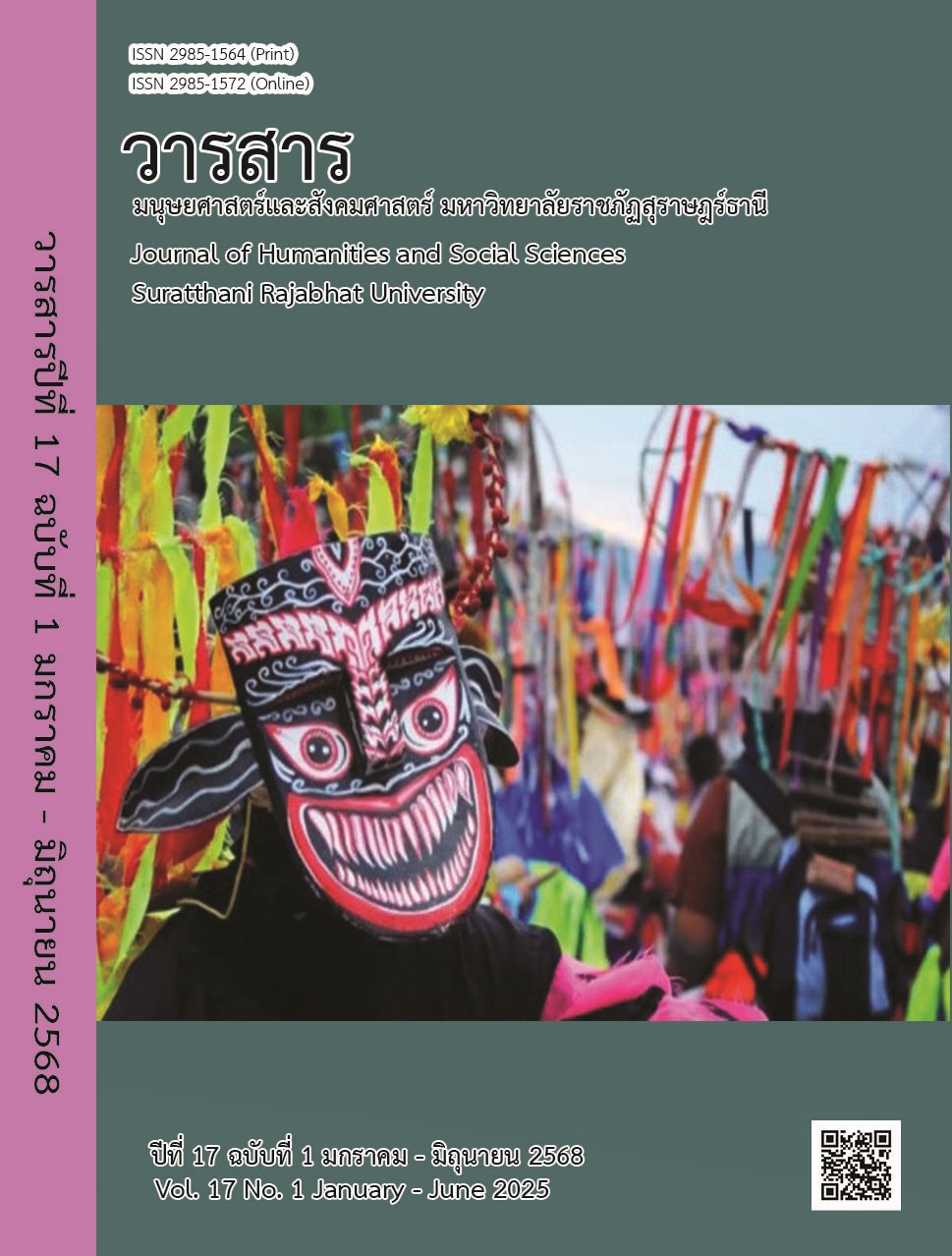การศึกษาปัจจัยในการปฏิบัติงานที่ส่งผลต่อความผูกพันต่อองค์กรของบุคลากรวิทยาลัยนวัตกรรมและการจัดการ มหาวิทยาลัยราชภัฏสวนสุนันทา
Main Article Content
บทคัดย่อ
บทความวิจัยนี้มีวัตถุประสงค์เพื่อ 1) ศึกษาระดับปัจจัยในการปฏิบัติงานและระดับความผูกพันต่อองค์กร และ 2) ปัจจัยในการปฏิบัติงานที่ส่งผลต่อความผูกพัน
ต่อองค์กรของบุคลากรวิทยาลัยนวัตกรรมและการจัดการ มหาวิทยาลัยราชภัฏสวนสุนันทา การวิจัยนี้ใช้ระเบียบวิธีวิจัยเชิงปริมาณ โดยใช้แบบสอบถามเป็นเครื่องมือในการเก็บรวบรวมข้อมูล กลุ่มตัวอย่างประกอบด้วยบุคลากรสายวิชาการและสายสนับสนุนวิชาการจำนวน 130 คน สถิติที่ใช้ในการวิเคราะห์ข้อมูลประกอบด้วยสถิติเชิงพรรณนา ได้แก่ ความถี่ ร้อยละ ค่าเฉลี่ย ส่วนเบี่ยงเบนมาตรฐาน ค่าสัมประสิทธิ์สหสัมพันธ์ และ
การวิเคราะห์ถดถอยพหุคูณแบบขั้นตอน
ผลการวิจัยพบว่า 1) ระดับปัจจัยในการปฏิบัติงานและระดับความผูกพันต่อองค์กรอยู่ในระดับมาก และ 2) ปัจจัยที่ส่งผลต่อความผูกพันต่อองค์กรอย่างมีนัยสำคัญทางสถิติ (p < 0.01) เรียงตามลำดับความสำคัญ ได้แก่ การทำงานเป็นทีมและมีส่วนร่วม ความมีจริยธรรม ความคิดสร้างสรรค์ และการมีวิสัยทัศน์นำการเปลี่ยนแปลง
ข้อเสนอแนะในการนำผลวิจัยไปใช้ ได้แก่ การพัฒนาโปรแกรมฝึกอบรม
เพื่อเสริมสร้างทักษะการทำงานเป็นทีม การจัดทำแนวปฏิบัติด้านจริยธรรมองค์กร การส่งเสริมวัฒนธรรมที่เอื้อต่อความคิดสร้างสรรค์ การพัฒนาภาวะผู้นำเชิงวิสัยทัศน์ และ
การออกแบบระบบประเมินผลการปฏิบัติงานที่สอดคล้องกับปัจจัยทั้ง 4 ด้าน เพื่อเพิ่มประสิทธิภาพการทำงานและความผูกพันต่อองค์กรของบุคลากรในสถาบันอุดมศึกษา
Article Details

อนุญาตภายใต้เงื่อนไข Creative Commons Attribution-NonCommercial-NoDerivatives 4.0 International License.
ต้นฉบับทุกเรื่องที่พิมพ์เผยแพร่ได้รับการตรวจสอบความถูกต้องทางวิชาการโดยผู้ทรงคุณวุฒิ (Peer Peview) เฉพาะสาขามนุษยศาสตร์และสังคมศาสตร์ การตีพิมพ์บทความซ้ำต้องได้รับการอนุญาตจากกองบรรณาธิการเป็นลายลักษณ์อักษร
เอกสารอ้างอิง
ธนาคาร แสงหวัง, เฉลิมชัย ปัญญาดี, และ ปิยะพงษ์ บุษบงก์. (2565). ความผูกพันต่อ
องค์การของบุคลากรมหาวิทยาลัยแม่โจ้. วารสารบริหารธุรกิจและศิลปศาสตร์
ราชมงคลล้านนา, 10(1), 14-27.
พิมพ์ปวีณ์ มะณีวงค์, วรรณภา ลือกิตินันท์, และ ปิยะวรรณ เลิศพานิช. (2564). ปัจจัยที่ส่ง
ผลต่อความผูกพันต่อองค์การของบุคลากรมหาวิทยาลัยเชียงใหม่. วารสาร
บริหารธุรกิจ มหาวิทยาลัยเชียงใหม่, 7(3), 37-61.
วราภรณ์ ชื่นจรูญ, และ เนตร์พัณณา ยาวิราช. (2565, มกราคม-เมษายน). อิทธิพลของความ
ผูกพันในองค์การและความพึงพอใจในงานที่มีผลต่อความจงรักภักดีต่อองค์การ
ของลูกจ้างชั่วคราว มหาวิทยาลัยเทคโนโลยีราชมงคลธัญบุรี. วารสารวิจัย
วิทยาการจัดการ มหาวิทยาลัยราชภัฏสุรินทร์, ุ6(2), 180-192.
ศศิวิมล มาลาพงษ์, และ สุทธิพงศ์ บุญผดุง. (2565, มกราคม-มิถุนายน). ภาวะผู้นำยุค
ดิจิทัลของผู้บริหารสถานศึกษาที่ส่งผลต่อประสิทธิผลของสถานศึกษาสังกัด
สำนักงานเขตพื้นที่การศึกษามัธยมศึกษากรุงเทพมหานคร เขต 2. วารสาร
วิชาการมหาวิทยาลัยราชภัฏกาญจนบุรี, 11(1), 88-102.
รัญชิดา ดาวเรือง, ศิริพร ห้วยแก้ว และ ธฤตาภา ปานบ้านเกร็ด. (2567). ปัจจัยที่ส่งผลต่อ
การลาออกของพนักงานสายงานการจัดการธุรกิจและผลกระทบที่มีต่อองค์กร.
วารสารวิทยาการจัดการวไลยอลงกรณ์, 5(3), 35-54.
สุธิดา แจ้งประจักษ์, ธีระวัฒน์ จันทึก, และ พิทักษ์ ศิริวงศ์. (2563). ปัจจัยที่มีอิทธิพลต่อ
ความผูกพันต่อองค์การของบุคลากรมหาวิทยาลัยราชภัฏในเขต
กรุงเทพมหานคร. Veridian E-Journal, Silpakorn University, 13(2), 1636-
Alzyoud, A. A. Y., Ahmed, U., AlZgool, M. R. H., & Pahi, M. H. (2019). Leaders'
emotional intelligence and employee retention: Mediation of job
satisfaction in the hospitality industry. International Journal of
Financial Research, 10(3), 1-10.
Amabile, T. M. (1996). Creativity in context: Update to “The Social
Psychology of Creativity”. Boulder, CO: Westview.
Bakker, A. B., & de Vries, J. D. (2021). Job Demands–Resources theory and
self-regulation: New explanations and remedies for job burnout.
Anxiety, Stress, & Coping, 34(1), 1-21.
Bakker, A. B., & Albrecht, S. (2018). Work Engagement: Current Trends. Career
Development International, 23(1), 4-11.
Best, J. W., & Kahn, J. V. (1993). Research in education (7th ed.). Boston: Allyn
and Bacon.
Chordiya, R., Sabharwal, M., & Goodman, D. (2021). Affective organizational
commitment and job satisfaction: A cross-national comparative
study. Public Administration, 95(1), 178-195.
Creswell, J. W., & Creswell, J. D. (2018). Research design: Qualitative,
quantitative, and mixed methods approaches (5th ed.). Thousand
Oaks, CA: SAGE Publications.
Etikan, I., Musa, S. A., & Alkassim, R. S. (2016). Comparison of convenience
sampling and purposive sampling. American Journal of Theoretical
and Applied Statistics, 5(1), 1-4.
Field, A. (2018). Discovering statistics using IBM SPSS Statistics (5th ed.).
London, UK: Sage Publications.
Frost, J. (2020). Regression analysis: An intuitive guide for using and
interpreting linear models. State College, PA: Statistics by Jim Publishing.
Ghasemy, M., Hussin, S., Hashemi, S. M., & Othman, N. (2018). Determining
factors of job satisfaction and organizational commitment in higher
education institutions: The role of leadership. Educational Management
Administration & Leadership, 46(1), 161–180. https://doi.
org/10.1177/1741143216672069
Hair, J. F., Black, W. C., Babin, B. J., & Anderson, R. E. (2019). Multivariate data
analysis (8th ed.). Boston, MA: Cengage Learning.
Katzenbach, J. R., & Smith, D. K. (2015). The wisdom of teams: Creating the
high-performance organization. Boston, MA: Harvard Business Review Press.
Kotter, J. P. (2012). Leading change. Boston, MA: Harvard Business Press.
Meyer, J. P., & Allen, N. J. (1991). A three-component conceptualization of
organizational commitment. Human Resource Management
Review, 1(1), 61-89.
Stevens, J. P. (1996). Applied multivariate statistics for the social sciences
(3rd ed.). Mahwah, NJ: Lawrence Erlbaum Associates
Treviño, L. K., Weaver, G. R., & Reynolds, S. J. (2006). Behavioral ethics in
organizations: A review. Journal of Management, 32(6), 951-990.
World Medical Association. (2013). World Medical Association Declaration of
Helsinki: Ethical principles for medical research involving human
subjects. JAMA, 310(20), 2191-2194.


